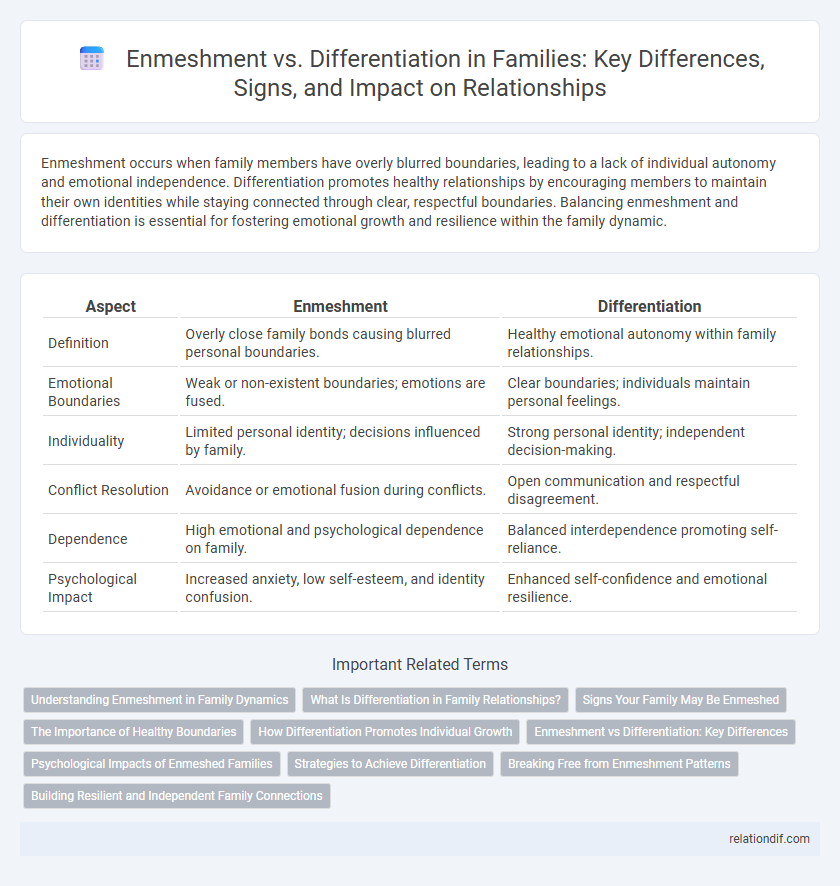Enmeshment occurs when family members have overly blurred boundaries, leading to a lack of individual autonomy and emotional independence. Differentiation promotes healthy relationships by encouraging members to maintain their own identities while staying connected through clear, respectful boundaries. Balancing enmeshment and differentiation is essential for fostering emotional growth and resilience within the family dynamic.
Table of Comparison
| Aspect | Enmeshment | Differentiation |
|---|---|---|
| Definition | Overly close family bonds causing blurred personal boundaries. | Healthy emotional autonomy within family relationships. |
| Emotional Boundaries | Weak or non-existent boundaries; emotions are fused. | Clear boundaries; individuals maintain personal feelings. |
| Individuality | Limited personal identity; decisions influenced by family. | Strong personal identity; independent decision-making. |
| Conflict Resolution | Avoidance or emotional fusion during conflicts. | Open communication and respectful disagreement. |
| Dependence | High emotional and psychological dependence on family. | Balanced interdependence promoting self-reliance. |
| Psychological Impact | Increased anxiety, low self-esteem, and identity confusion. | Enhanced self-confidence and emotional resilience. |
Understanding Enmeshment in Family Dynamics
Enmeshment in family dynamics refers to overly close emotional boundaries where individual identities are blurred, leading to dependency and limited personal autonomy. This lack of differentiation often causes difficulties in establishing healthy relationships outside the family unit, affecting emotional development and self-esteem. Recognizing enmeshment is crucial for promoting emotional independence and fostering balanced familial relationships.
What Is Differentiation in Family Relationships?
Differentiation in family relationships refers to the ability of individuals to maintain their own identity while staying emotionally connected to family members. It involves balancing autonomy and intimacy, allowing family members to express their personal beliefs and feelings without fear of rejection. High differentiation promotes healthy boundaries, emotional resilience, and effective communication within family systems.
Signs Your Family May Be Enmeshed
Persistent difficulty making independent decisions, intense emotional dependence on family members, and invasive involvement in personal boundaries are key signs your family may be enmeshed. Family members often prioritize collective identity over individual needs, leading to blurred personal boundaries and lack of autonomy. This enmeshment can result in increased anxiety, low self-esteem, and challenges in establishing healthy interpersonal relationships outside the family unit.
The Importance of Healthy Boundaries
Healthy boundaries in families are essential for maintaining individual identity while fostering connection, preventing enmeshment where personal limits become blurred. Differentiation allows family members to express emotions and make decisions independently, contributing to emotional resilience and healthier relationships. Establishing clear, respectful boundaries supports mutual respect and personal growth within the family system.
How Differentiation Promotes Individual Growth
Differentiation fosters individual growth by enabling family members to maintain their sense of self while remaining emotionally connected, which reduces anxiety and promotes resilience. This balance allows individuals to pursue personal goals, develop independent thinking, and make autonomous decisions without fear of rejection. Healthy differentiation leads to stronger family relationships as members respect each other's boundaries and support each other's unique identities.
Enmeshment vs Differentiation: Key Differences
Enmeshment involves blurred boundaries where individual identities within a family are intertwined, leading to emotional dependence and loss of autonomy. Differentiation refers to the ability to maintain a strong sense of self while remaining emotionally connected, supporting healthy independence and mutual respect. Key differences highlight enmeshment's lack of personal boundaries versus differentiation's balance of intimacy and selfhood.
Psychological Impacts of Enmeshed Families
Enmeshed families often blur personal boundaries, leading to diminished individual autonomy and heightened dependency among members. This psychological entanglement can cause identity confusion, anxiety, and difficulty in establishing healthy interpersonal relationships outside the family unit. Such environments may increase vulnerability to emotional distress, depression, and hinder personal growth, impacting overall mental well-being.
Strategies to Achieve Differentiation
Effective strategies to achieve differentiation within family systems include establishing clear personal boundaries and fostering open communication that respects individual perspectives. Encouraging self-awareness and emotional regulation helps family members maintain autonomy while staying connected. Practicing assertiveness and seeking external support such as therapy can further promote healthy differentiation and reduce enmeshment.
Breaking Free from Enmeshment Patterns
Breaking free from enmeshment patterns involves establishing clear personal boundaries and recognizing individual identity within family dynamics. Differentiation empowers family members to express their authentic emotions and thoughts without fear of rejection or loss of connection. This process fosters healthier communication and emotional autonomy, promoting balanced and supportive relationships.
Building Resilient and Independent Family Connections
Enmeshment in families often leads to blurred boundaries and dependence, hindering individual growth and autonomy. Differentiation promotes healthy emotional separation while maintaining strong relational bonds, enabling family members to develop resilience and independence. Balancing connection with personal identity fosters adaptive family dynamics and long-term psychological well-being.
Enmeshment vs Differentiation Infographic

 relationdif.com
relationdif.com